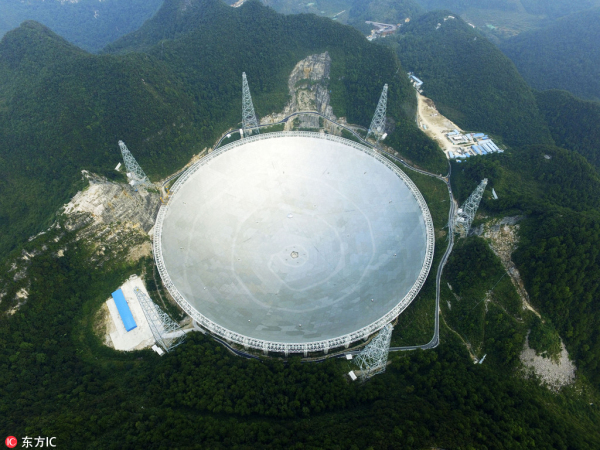
 |
|
Aerial view of the world's largest radio telescope called FAST (Five-hundred-meter Aperture Spherical Telescope) in Pingtang county, Qiannan Buyi and Miao Autonomous Prefecture, southwest China's Guizhou province, 25 September 2016.[Photo/IC] |
"The eye of heaven is open for tourists now!" The news quickly spread across the internet. The "eye of heaven" refers to the Five-hundred-meter Aperture Spherical Telescope (or FAST), the largest in the world, used to gaze into the depths of the universe.
Parts of the FAST zone, in Pingtang county of Southwest China's Guizhou province, were opened to tourists in late September. By paying 368 yuan ($55.18) for a ticket, tourists can visit certain parts of the observatory. And as expected, 140,000 people visited the FAST zone during the just-concluded weeklong National Day holiday.
Opening parts of the FAST zone to tourists has its advantages. For one, it can generate some income.
FAST is rather expensive: Its telescope arrays alone cost 700 million yuan ($105 million). Its control center was built with carefully selected materials and decorated with nothing but wood panels to minimize the influence of external electromagnetic waves. And a huge amount of money will be needed every year for maintenance of the observatory. Moreover, FAST will not make any immediate returns and its team must apply for State funding which involves complicated procedures. So the ticket revenue will be a welcome source of income (even if small).
As the largest radio telescope in the world, FAST is already well known among Chinese astronomers and astronomy fans, the partial opening of the zone to visitors will give other people an opportunity to experience it firsthand.
According to reports, the parts of the FAST open to tourists include an astronomy experience museum, in which people can feel as if they are among the stars thanks to three-dimensional simulation technology, and a telescope area where people can peer into the sky through optical telescopes. On the sightseeing platform, they can have a glimpse of FAST, albeit from a distance. Most pictures of FAST we see online were taken from this platform.
The partial opening of the FAST zone to tourists seems to be a win-win move at present: It will not only help generate some revenue to support scientific research, but also help infuse the love for science among youngsters and ordinary people.
But there are some problems, too. FAST has strict environmental requirements-reports say that every light bulb in the control center of FAST is specially manufactured and has to pass dozens of tests before being installed. That is why those entering the tourist area are not allowed to carry, let alone use, electronic devices such as cellphones.
Besides, one of the reasons a mountainous area was chosen as the location for FAST is the low population density-both the device and the scientists need silent surroundings. With the FAST zone being partly opened to tourists, and many people visiting the site, some locals are building new hotels in the area. As a result, the peaceful, serene place could soon become a tourist hub.
The FAST observatory employees and tourists must be careful not to break the noise limits and other rules, but still it cannot be guaranteed that the surroundings will not be disturbed. For example, their original rule is to limit the number of tourists to within 2,000 a day, but the actual number of tourists entering the FAST zone on Oct 1 exceeded 10,000. A local policeman in Pingdu is even reported as saying they had to persuade tourists to change their minds.
If the upper limit of tourist number is broken, there is reason to worry that other rules, which are aimed at protecting FAST from external disturbance, might be broken, too. How to minimize the disturbance will be a major challenge for the FAST zone administrative staff and related governmental authorities.
The author is a writer with China Daily. zhangzhouxiang@chinadaily.com.cn